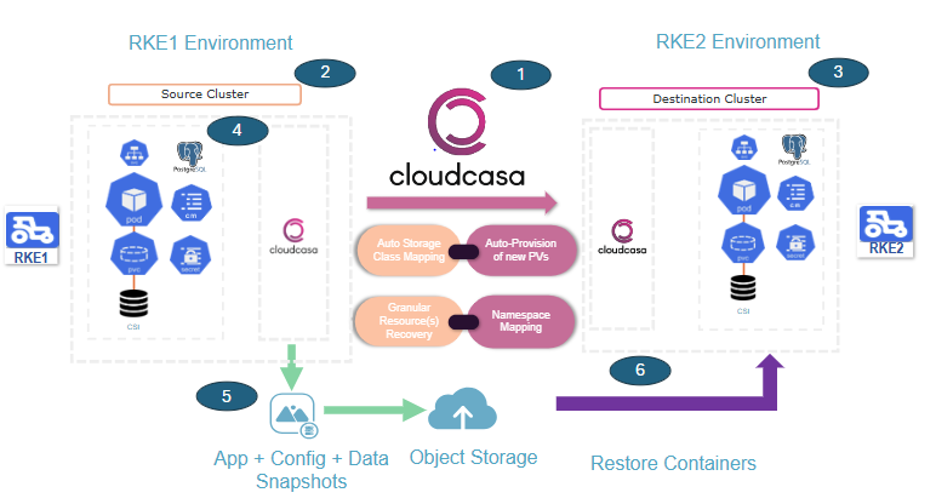As the Kubernetes landscape continues to evolve, there is often the need to adapt to newer, more robust distributions. SUSE has announced the end of life of RKE (Rancher Kubernetes Engine) in favor of RKE2, a Kubernetes distribution designed with enhanced security, resilience, and scalability. For organizations running workloads on RKE, this shift marks an important milestone—but it also raises questions about how to migrate workloads safely and efficiently.
CloudCasa, a SUSE Certified Partner Solution, is here to simplify this transition. Whether you’re conducting testing of your applications on RKE2, migrating your production clusters, ensuring continuity in data protection, or planning for disaster recovery during the migration, our Kubernetes backup and recovery solution is built to meet your needs.
Why the Transition to RKE2?
Transitioning to RKE2 offers numerous advantages for organizations seeking a more secure, scalable, and future-proof container orchestration platform. Unlike RKE, which relies on Docker—a container runtime no longer actively maintained—RKE2 adopts a more modern and efficient container environment (containerd), enhancing performance and security. With security at its core, RKE2 is designed to help clusters meet the rigorous CIS Kubernetes Benchmarks with minimal configuration, ensuring robust defense against potential vulnerabilities. It also supports FIPS 140-2 compliance and reduces CVEs by leveraging comprehensive scanning with Trivy during the build process.
By combining the best features of RKE and K3S, RKE2 delivers a powerful, scalable solution that is well-positioned to meet the evolving demands of modern applications.The official EoL of RKE means that businesses must eventually transition to RKE2 to ensure ongoing support and benefit from these enhanced features. This can be a complex process, especially for teams managing multiple clusters and workloads.
CloudCasa: Your Partner in Migration
As a SUSE Certified Partner Solution, CloudCasa is uniquely positioned to assist organizations migrating to RKE2. Our solution provides:
- Backup and Restore for RKE and RKE2: CloudCasa ensures that your workloads are protected before, during, and after migration. With easy-to-use backup capabilities, you can safeguard applications running on RKE before migrating them to RKE2, ensuring that no data is lost during the transition.
- Pre-migration testing: CloudCasa can help you with pre-migration testing, replicating persistent data from your RKE production cluster to your RKE2 target cluster to verify application function.
- Migration of persistent data: CloudCasa can again move Kubernetes resources from your source RKE cluster to your target RKE2 cluster during production migration, greatly simplifying migration of stateful application that can’t simply be spun up on the new cluster.
- Disaster Recovery During Migration: Migrations can sometimes be unpredictable. Did someone delete data from the wrong cluster, or forget to include a namespace as part of the migration, after working all night? CloudCasa enables you to restore workloads to a functional state quickly in case of migration failures, errors, or other issues.
- Centralized Management Across Kubernetes Distributions: CloudCasa supports a wide range of Kubernetes distributions, including RKE, RKE2, OpenShift, AKS, EKS, and GKE. This ensures that as you migrate between clusters, you have a single pane of glass to manage backups and restores across your environments.
- Compliance Support: Our solution helps you maintain compliance during and after the migration process, ensuring that backups and restores are auditable and secure.
- SUSE Ecosystem Integration: CloudCasa integrates seamlessly with the SUSE ecosystem, including SUSE Virtualization (Harvester), Longhorn, and other SUSE-supported tools, offering you an end-to-end solution for managing your Kubernetes environments.
CloudCasa: Step-by-step Migration Workflow
1. Sign Up for CloudCasa
Start your migration journey by signing up for CloudCasa.
2. Add the Source Kubernetes Cluster (RKE)
Once you’re logged into CloudCasa:
- Navigate to the Clusters section and select Add Cluster.
- Register your RKE cluster by following the on-screen instructions.
- Install the lightweight CloudCasa agent on your RKE cluster. This agent will enable CloudCasa to back up namespaces, persistent volumes, and cluster-scoped resources necessary for the migration.
3. Add the Target Kubernetes Cluster (RKE2)
Similarly, register the destination RKE2 cluster:
- Navigate back to the Clusters section and repeat the Add Cluster process for RKE2.
- Install the CloudCasa agent on your RKE2 cluster. This setup prepares the cluster to receive the restored workloads and configurations.
4. Define a Migration Job
CloudCasa’s migration feature lets you specify exactly what you want to move:
- Go to the Migration Jobs section and create a new job.
- Select the source cluster (RKE) from the drop-down list.
- Choose the namespaces and cluster-scoped resources you need to migrate. These may include ConfigMaps, Secrets, and RBAC policies critical for application functionality on the target cluster.
5. Specify the Target Cluster (RKE2)
During the migration job setup:
- Define RKE2 as the destination cluster.
- CloudCasa will automatically map the selected resources from RKE to RKE2, ensuring compatibility between the two environments.
6. Execute the Restore Transformation
Run the migration job to initiate the process:
- CloudCasa will back up the selected namespaces, persistent volumes, and cluster resources from RKE.
- It will then restore these resources into the RKE2 cluster, transforming them as needed to ensure they work seamlessly in the new environments.
Migration Workflow Diagram
Get Started with CloudCasa and RKE2 Migration
Transitioning to RKE2 doesn’t have to be daunting. CloudCasa simplifies the process, helping you protect your workloads, migrate with confidence, and embrace the future of Kubernetes with SUSE.
Take Action Today:
As RKE approaches EoL, there’s no better time to plan your migration. Watch our video to see how easy it is to migrate from RKE to RKE2 or learn more about how CloudCasa can assist with your RKE2 transition by visiting CloudCasa.io or contacting us at casa@cloudcasa.io.
Explore our SUSE partnership and how we’re leading the convergence of Kubernetes and virtualization here: SUSE and CloudCasa.
Embrace the next generation of Kubernetes with confidence—partner with CloudCasa for a seamless migration journey.
